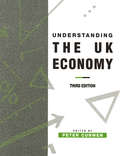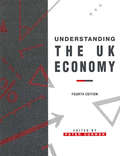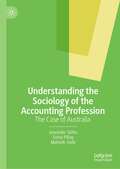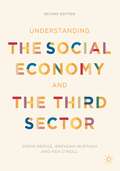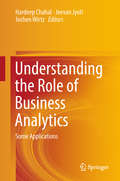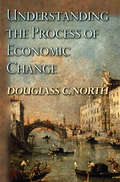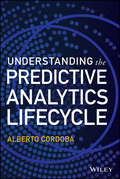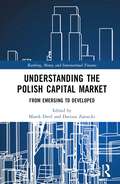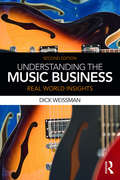- Table View
- List View
Understanding the UK Economy (Palgrave Texts in Econometrics)
This third edition has been completely revised and updated to take account of recent developments. The contributors apply economic analysis to the UK economy using an extensive database, producing a guide to the UK economy for economics and business students.
Understanding the UK Economy (Texts in Economics)
Fully revised, updated and with a new user-friendly format, the fourth edition of this popular book continues to provide an excellent introduction to the UK economy. Once again, Peter Curwen and his team of experts apply economic analysis to the UK economy using their extensive database and the result is a clear and incisive guide for economics and business students.
Understanding the Sociology of the Accounting Profession: The Case of Australia
by Jasvinder Sidhu Soma Pillay Mahesh JoshiThis book presents the first non-European and non-North American comprehensive study explaining failures of key merger attempts by Australia’s two leading accounting bodies.It employs two complementary theoretical constructs namely, boundary work and exclusiveness versus market control, to explain the maintenance of professional boundaries in the Australian accounting profession.In doing so, it illustrates key historical developments in Australia’s society, economy and business world towards shaping the present structure and operations of the accounting profession, and the remaining professional bodies at the national level.
Understanding the Social Economy and the Third Sector
by Simon Bridge Ken O'Neill Brendan MurtaghUnderstanding the Social Economy and the Third Sector fills a significant gap by bringing together a comprehensive range of topics in one resource. Students will gain a working knowledge of the social economy and social capital, illustrated by comparison with the private and public sectors and real-world examples.
Understanding the Role of Business Analytics: Some Applications
by Jochen Wirtz Jeevan Jyoti Hardeep ChahalThis book encompasses empirical evidences to understand the application of data analytical techniques in emerging contexts. Varied studies relating to manufacturing and services sectors including healthcare, banking, information technology, power, education sector etc. stresses upon the systematic approach followed in applying the data analytical techniques; and also analyses how these techniques are effective in decision-making in different contexts. Especially, the application of regression modeling, financial modelling, multi-group modeling, cluster analysis, and sentiment analysis will help the readers in understanding critical business scenarios in the best possible way, and which later can help them in arriving at best solution for the business related problems. The individual chapters will help the readers in understanding the role of specific data analytic tools and techniques in resolving business operational issues experienced in manufacturing and service organisations in India and in developing countries. The book offers a relevant resource that will help readers in the application and interpretation of data analytical statistical practices relating to emerging issues like customer experience, marketing capability, quality of manufactured products, strategic orientation, high-performance human resource policy, employee resilience, financial resources, etc. This book will be of interest to a professional audience that include practitioners, policy makers, NGOs, managers and employees as well as academicians, researchers and students.
Understanding the Relationship Between Networks and Technology, Creativity and Innovation (Technology, Innovation, Entrepreneurship and Competitive Strategy #13)
by Barak S. Aharonson Shmuel Ellis Terry L. Amburgey Israel Drori Uriel StettnerAn exciting new volume in the Technology, Innovation, Entrepreneurship and Competitive Strategy series from Emerald's popular Strategy collection. This volume features excellent new research devoted to advancing our understanding of how networks foster creativity, innovation and the development of cutting-edge technologies. Contributions offer unique perspectives on the significance of networks to the financial success of businesses, in addition to giving examples of how these can be crucial in bringing about creativity and innovation. It deals with the evolution of networks through geographic and industry boundaries. This is crucial reading for any researchers exploring strategic management tools and techniques, and specifically the intricacies of "network theory" within businesses.
Understanding the Professional Buyer: What Every Sales Professional Should Know About How the Modern Buyer Thinks and Behaves
by Peter Cheverton Jan Paul Van Der VeldeUnderstanding the Professional Buyer is a practical guide for sales people, giving them insight into the behaviour and strategies of buyers, so that they are able to deal with them more successfully and regain power in the buyer-seller relationship.In recent years the balance of power between buyer and seller has swung dramatically in favour of the buyer. Sellers are now faced with more professional, more knowledgeable and more powerful buyers - and the sales techniques used in previous years are no longer working. This book shows how to understand this new breed of buyer, in order to interact with them on a more level playing field. Contents include developments in the industry; purchasing organizations; types of buyers; purchasing analysis; and crucially, buyer-seller relations.
Understanding the Professional Buyer: What Every Sales Professional Should Know About How the Modern Buyer Thinks and Behaves
by Peter Cheverton Jan Paul Van Der VeldeUnderstanding the Professional Buyer is a practical guide for sales people, giving them insight into the behaviour and strategies of buyers, so that they are able to deal with them more successfully and regain power in the buyer-seller relationship.In recent years the balance of power between buyer and seller has swung dramatically in favour of the buyer. Sellers are now faced with more professional, more knowledgeable and more powerful buyers - and the sales techniques used in previous years are no longer working. This book shows how to understand this new breed of buyer, in order to interact with them on a more level playing field. Contents include developments in the industry; purchasing organizations; types of buyers; purchasing analysis; and crucially, buyer-seller relations.
Understanding the Process of Economic Change
by Douglass C. NorthIn this landmark work, a Nobel Prize-winning economist develops a new way of understanding the process by which economies change. Douglass North inspired a revolution in economic history a generation ago by demonstrating that economic performance is determined largely by the kind and quality of institutions that support markets. As he showed in two now classic books that inspired the New Institutional Economics (today a subfield of economics), property rights and transaction costs are fundamental determinants. Here, North explains how different societies arrive at the institutional infrastructure that greatly determines their economic trajectories. North argues that economic change depends largely on "adaptive efficiency," a society's effectiveness in creating institutions that are productive, stable, fair, and broadly accepted--and, importantly, flexible enough to be changed or replaced in response to political and economic feedback. While adhering to his earlier definition of institutions as the formal and informal rules that constrain human economic behavior, he extends his analysis to explore the deeper determinants of how these rules evolve and how economies change. Drawing on recent work by psychologists, he identifies intentionality as the crucial variable and proceeds to demonstrate how intentionality emerges as the product of social learning and how it then shapes the economy's institutional foundations and thus its capacity to adapt to changing circumstances. Understanding the Process of Economic Change accounts not only for past institutional change but also for the diverse performance of present-day economies. This major work is therefore also an essential guide to improving the performance of developing countries.
Understanding the Predictive Analytics Lifecycle (Wiley and SAS Business Series)
by Alberto CordobaA high-level, informal look at the different stages of the predictive analytics cycle Understanding the Predictive Analytics Lifecycle covers each phase of the development of a predictive analytics initiative. Through the use of illuminating case studies across a range of industries that include banking, megaresorts, mobile operators, healthcare, manufacturing, and retail, the book successfully illustrates each phase of the predictive analytics cycle to create a playbook for future projects. Predictive business analytics involves a wide variety of inputs that include individuals' skills, technologies, tools, and processes. To create a successful analytics program or project to gain forward-looking insight into making business decisions and actions, all of these factors must properly align. The book focuses on developing new insights and understanding business performance based on extensive use of data, statistical and quantitative analysis, explanatory and predictive modeling, and fact-based management as input for human decisions. The book includes: An overview of all relevant phases: design, prepare, explore, model, communicate, and measure Coverage of the stages of the predictive analytics cycle across different industries and countries A chapter dedicated to each of the phases of the development of a predictive initiative A comprehensive overview of the entire analytic process lifecycle If you're an executive looking to understand the predictive analytics lifecycle, this is a must-read resource and reference guide.
Understanding the Predictive Analytics Lifecycle (Wiley and SAS Business Series)
by Alberto CordobaA high-level, informal look at the different stages of the predictive analytics cycle Understanding the Predictive Analytics Lifecycle covers each phase of the development of a predictive analytics initiative. Through the use of illuminating case studies across a range of industries that include banking, megaresorts, mobile operators, healthcare, manufacturing, and retail, the book successfully illustrates each phase of the predictive analytics cycle to create a playbook for future projects. Predictive business analytics involves a wide variety of inputs that include individuals' skills, technologies, tools, and processes. To create a successful analytics program or project to gain forward-looking insight into making business decisions and actions, all of these factors must properly align. The book focuses on developing new insights and understanding business performance based on extensive use of data, statistical and quantitative analysis, explanatory and predictive modeling, and fact-based management as input for human decisions. The book includes: An overview of all relevant phases: design, prepare, explore, model, communicate, and measure Coverage of the stages of the predictive analytics cycle across different industries and countries A chapter dedicated to each of the phases of the development of a predictive initiative A comprehensive overview of the entire analytic process lifecycle If you're an executive looking to understand the predictive analytics lifecycle, this is a must-read resource and reference guide.
Understanding the Polish Capital Market: From Emerging to Developed (Banking, Money and International Finance)
by Marek DietlThe first stock exchange in Warsaw – capital city of the Kingdom of Poland– was established in 1817. Over the past 205 years, the fortunes of the capital market have been closely linked to the "bumpy road" of Polish history. The establishment of the GPW Warsaw Stock Exchange in 1991 was a landmark for transformation from a centrally planned communist economy to a market-driven capitalist one. Since the doors of the exchange reopened, Polish GDP per capita (current USD) increased eight times, translating into an average yearly growth rate of over 7%. The capital market has played a pivotal role in the economic success of Poland over the last three decades. It is not easy to precisely quantify the impact, as it was rather a spill-over effect. Economic growth has fostered the development of a capital market, and more efficient conversion of savings to investments via the capital market. The excellence of capital market institutions can be gauged with reference to various parameters. A synthetic measure is so-called market status. According to FTSE Russell (global index provider), Polish capital attained developed market status in 2018, being the first and only post-communist state to do so. It is fair to say that transformation has been completed and developed market status indicates clearly that the institutions and regulations are world class. The current challenge is competing with other developed markets for the best issuers and offering the most demanding investors an excellent trading experience. This book offers scientific insight into the Polish capital market story. Authored by a group of renowned scholars, with contributions aspiring to the highest academic standards for theoretical considerations and empirical research. The book covers various topics, including links between monetary policy and capital markets, micro and macro market structures, and investors and issuers' behaviour and strategies. All chapters are rooted in contemporary finance theory, supported by various econometric models based on the most recently available data. The book aims to provide academics and practitioners insight into the Polish capital market, appealing especially to those interested in gaining a deeper understanding of emerging markets' successful transformation into developed ones. It can also be used as supplementary reading for doctoral and master’s students in finance, particularly relating to capital markets and economics – predominantly development economics and economic policy.
Understanding the Polish Capital Market: From Emerging to Developed (Banking, Money and International Finance)
by Marek Dietl Dariusz ZarzeckiThe first stock exchange in Warsaw – capital city of the Kingdom of Poland– was established in 1817. Over the past 205 years, the fortunes of the capital market have been closely linked to the "bumpy road" of Polish history. The establishment of the GPW Warsaw Stock Exchange in 1991 was a landmark for transformation from a centrally planned communist economy to a market-driven capitalist one. Since the doors of the exchange reopened, Polish GDP per capita (current USD) increased eight times, translating into an average yearly growth rate of over 7%. The capital market has played a pivotal role in the economic success of Poland over the last three decades. It is not easy to precisely quantify the impact, as it was rather a spill-over effect. Economic growth has fostered the development of a capital market, and more efficient conversion of savings to investments via the capital market. The excellence of capital market institutions can be gauged with reference to various parameters. A synthetic measure is so-called market status. According to FTSE Russell (global index provider), Polish capital attained developed market status in 2018, being the first and only post-communist state to do so. It is fair to say that transformation has been completed and developed market status indicates clearly that the institutions and regulations are world class. The current challenge is competing with other developed markets for the best issuers and offering the most demanding investors an excellent trading experience. This book offers scientific insight into the Polish capital market story. Authored by a group of renowned scholars, with contributions aspiring to the highest academic standards for theoretical considerations and empirical research. The book covers various topics, including links between monetary policy and capital markets, micro and macro market structures, and investors and issuers' behaviour and strategies. All chapters are rooted in contemporary finance theory, supported by various econometric models based on the most recently available data. The book aims to provide academics and practitioners insight into the Polish capital market, appealing especially to those interested in gaining a deeper understanding of emerging markets' successful transformation into developed ones. It can also be used as supplementary reading for doctoral and master’s students in finance, particularly relating to capital markets and economics – predominantly development economics and economic policy.
Understanding the Olympics
by John Horne Garry WhannelHow did the Olympics evolve into a multi-national phenomenon? How can the Olympics help us to understand the relationship between sport and society? What will be the impact and legacy of the Olympics after Tokyo in 2020? Understanding the Olympics answers all these questions by exploring the social, cultural, political, historical, and economic context of the Games. This thoroughly revised and updated edition discusses recent attempts at future proofing by the International Olympic Committee (IOC) in the face of growing global anti-Olympic activism, the changing geo-political context within which the Olympics take place, and the Olympic histories of the next three cities to host the Games – Tokyo (2020), Paris (2024), and Los Angeles (2028) – as well as the legacy of the London (2012) Olympics. For the first time, this new edition introduces the reader to the emergence of ‘other Games’ associated with the IOC – the Winter Olympics, the Paralympics, and the Youth Olympics. It also features a full Olympic history timeline, many new photographs, refreshed suggestions for further reading, and revised illustrations. The most up-to-date and authoritative textbook available on the Olympic Games, Understanding the Olympics is essential reading for anybody with an interest in the Olympics or the wider relationship between sport and society.
Understanding the Olympics
by John Horne Garry WhannelHow did the Olympics evolve into a multi-national phenomenon? How can the Olympics help us to understand the relationship between sport and society? What will be the impact and legacy of the Olympics after Tokyo in 2020? Understanding the Olympics answers all these questions by exploring the social, cultural, political, historical, and economic context of the Games. This thoroughly revised and updated edition discusses recent attempts at future proofing by the International Olympic Committee (IOC) in the face of growing global anti-Olympic activism, the changing geo-political context within which the Olympics take place, and the Olympic histories of the next three cities to host the Games – Tokyo (2020), Paris (2024), and Los Angeles (2028) – as well as the legacy of the London (2012) Olympics. For the first time, this new edition introduces the reader to the emergence of ‘other Games’ associated with the IOC – the Winter Olympics, the Paralympics, and the Youth Olympics. It also features a full Olympic history timeline, many new photographs, refreshed suggestions for further reading, and revised illustrations. The most up-to-date and authoritative textbook available on the Olympic Games, Understanding the Olympics is essential reading for anybody with an interest in the Olympics or the wider relationship between sport and society.
Understanding the New Global Economy: A European Perspective
by Harald SanderUnderstanding the New Global Economy: A European Perspective argues that globalisation is facing economic and political headwinds. A new global economic geography is emerging, cross-border relationships are changing, and global governance structures must come to terms with a new multipolar world. This book clarifies the fundamental questions and trade-offs in this new global economy, and gives readers the tools to understand contemporary debates. It presents a range of possible policy options, without being prescriptive. Following a modular structure, each chapter takes a similar approach but can also be read as a stand-alone piece. State-of-the-art academic research and historical experiences are weaved throughout the book, and readers are pointed towards relevant sources of information . This text is an accessible guide to the contemporary world economy, suited to students of international economics, political economy, globalisation, and European studies. It will also be valuable reading for researchers, professionals, and general readers interested in economics, politics, and civil society.
Understanding the New Global Economy: A European Perspective
by Harald SanderUnderstanding the New Global Economy: A European Perspective argues that globalisation is facing economic and political headwinds. A new global economic geography is emerging, cross-border relationships are changing, and global governance structures must come to terms with a new multipolar world. This book clarifies the fundamental questions and trade-offs in this new global economy, and gives readers the tools to understand contemporary debates. It presents a range of possible policy options, without being prescriptive. Following a modular structure, each chapter takes a similar approach but can also be read as a stand-alone piece. State-of-the-art academic research and historical experiences are weaved throughout the book, and readers are pointed towards relevant sources of information . This text is an accessible guide to the contemporary world economy, suited to students of international economics, political economy, globalisation, and European studies. It will also be valuable reading for researchers, professionals, and general readers interested in economics, politics, and civil society.
Understanding the New European Data Protection Rules
by Paul LambertCompared to the US, European data and privacy protection rules seem Draconian. The European rules apply to any enterprise doing business in the EU. The new rules are far more stringent than the last set. This book is a quick guide to the directives for companies, particularly US, that have to comply with them. Where US organizations and businesses who collect or receive EU personal data fail to comply with the rule, the bottom line can suffer from very significant official fines and penalties, as well as from users, customers or representative bodies to pursuing litigation. This guide is essential for all US enterprises who directly or indirectly deal with EU personal data.
Understanding the New European Data Protection Rules
by Paul LambertCompared to the US, European data and privacy protection rules seem Draconian. The European rules apply to any enterprise doing business in the EU. The new rules are far more stringent than the last set. This book is a quick guide to the directives for companies, particularly US, that have to comply with them. Where US organizations and businesses who collect or receive EU personal data fail to comply with the rule, the bottom line can suffer from very significant official fines and penalties, as well as from users, customers or representative bodies to pursuing litigation. This guide is essential for all US enterprises who directly or indirectly deal with EU personal data.
Understanding the New Business Paradigm in Eastern Europe: Lessons on Building a Successful Small Business
by Robert KozielskiIt is beyond a doubt that the business landscape is constantly changing with every small business looking for the next competitive advantage. In Understanding the New Business Paradigm in Eastern Europe, Kozielski presents a universal model for building a successful business in these hectic times. His four-tiered model is based on lessons learned from both developed and emerging markets across Eastern Europe, and is neither limited to one type of organization or a market, nor has any geographical borders. Called the "four-leaf clover," Kozielski's model features the experiences of such companies as mBank (part of Commerzbank), Aflofarm, Atlas, Redan, Sphinx and more. This work will be of interest to academics and professional who are looking for a holistic and systematic approach to successful small business management.
Understanding the New Business Paradigm in Eastern Europe: Lessons on Building a Successful Small Business
by Robert KozielskiIt is beyond a doubt that the business landscape is constantly changing with every small business looking for the next competitive advantage. In Understanding the New Business Paradigm in Eastern Europe, Kozielski presents a universal model for building a successful business in these hectic times. His four-tiered model is based on lessons learned from both developed and emerging markets across Eastern Europe, and is neither limited to one type of organization or a market, nor has any geographical borders. Called the "four-leaf clover," Kozielski's model features the experiences of such companies as mBank (part of Commerzbank), Aflofarm, Atlas, Redan, Sphinx and more. This work will be of interest to academics and professional who are looking for a holistic and systematic approach to successful small business management.
Understanding the Myth of High Growth Firms: The Theory of the Greater Fool (SpringerBriefs in Business)
by Malin Brännback Alan L. Carsrud Niklas KiviluotoIn this volume, the authors challenge some long held assumptions about entrepreneurial firms held by academics, public policy makers, investors and even entrepreneurs themselves. The first is assumption is that growth is what really differentiates an entrepreneurial firm from a small business. The second is that growth is always good. Third, if growth is rapid, and/or high growth, it is even better.Drawing from a fresh review of the literature, their own primary research and experience in entrepreneurial ventures, the authors argue that the relationship between growth and firm performance is, in fact, inconclusive. Despite the strength of contemporary bias, there is strong evidence that the growth-profitability relationship is problematic. For example, rapid growth may lead to considerable organizational challenges that can seriously constrain a firm’s ability to generate sustainable profits. Also, it is not uncommon that a growth firm becomes a victim of its own success.Using examples from industries as diverse as airlines, accounting, biotechnology, information technology, personal products, wineries, and food establishments, the authors highlight limitations to research due to variations in the choice of growth indicators, the calculation of growth measures, the measurement periods, and whether objective or subjective measures have been used. Moreover, researchers have equated growth with high growth and almost automatically assumed that this also means high technology, while policy makers appear to have interpreted this as high employment.Armed with more precise definitions and understandings of key concepts and the nature of their causality, the authors consider the implications of restoring profitability to the core of entrepreneurship for future research, firm strategy, financing, organizational structure, resource allocation, and public policy.
Understanding the Music Business: Real World Insights
by Dick WeissmanIn today’s fast-moving music industry, what does it take to build a life-long career? Now more than ever, all those working in music need to be aware of many aspects of the business, and take control of their own careers. Understanding the Music Business offers students a concise yet comprehensive overview of the rapidly evolving music industry, rooted in real-world experiences. Anchored by a wealth of career profiles and case studies, this second edition has been updated throughout to include the most important contemporary developments, including the advent of streaming and the shift to a DIY paradigm. A new "Both Sides Now" feature helps readers understand differing opinions on key issues. Highly readable, Understanding the Music Business is the perfect introduction for anyone seeking to understand how musical talents connect to making a living.
Understanding the Music Business: Real World Insights
by Dick WeissmanIn today’s fast-moving music industry, what does it take to build a life-long career? Now more than ever, all those working in music need to be aware of many aspects of the business, and take control of their own careers. Understanding the Music Business offers students a concise yet comprehensive overview of the rapidly evolving music industry, rooted in real-world experiences. Anchored by a wealth of career profiles and case studies, this second edition has been updated throughout to include the most important contemporary developments, including the advent of streaming and the shift to a DIY paradigm. A new "Both Sides Now" feature helps readers understand differing opinions on key issues. Highly readable, Understanding the Music Business is the perfect introduction for anyone seeking to understand how musical talents connect to making a living.
Understanding the Montessori Approach: Early Years Education in Practice (Understanding the… Approach)
by Barbara IsaacsUnderstanding the Montessori Approach is a much-needed source of information for those wishing to extend and consolidate their understanding of the Montessori Approach and how it is used in the teaching and learning of young children. The book will enable the reader to analyse the essential elements of this Approach to early childhood and and its relationship to quality early years practice. This second edition has been fully updated to reflect changes in the Early Years Foundation Stage and includes a fresh examination of the relationship between technology and the Montessori approach, as well as a brand new chapter, Learning in Montessori Settings. Exploring all areas of the curriculum including the organisation of Montessori schools, the environment, learning and teaching and the outcomes for children, this book: examines the historical context of the Montessori approach and its relevance to modern-day education; explores Montessori's views of child development and the role of the learning environment in a child’s educational development; details the organisation of Montessori schools worldwide and the structure of a typical day in a Montessori setting; highlights the principles of Montessori pedagogy, including the tools and strategies employed by its practitioners; considers how and what children learn in a Montessori setting and the links with EYFS 2017; includes new benefits and challenges of the Montessori approach to children's lives. Understanding the Montessori Approach provides an accessible overview of this major pedagogical influence on early years practice, supported by case studies, examples, summaries and reflective practice questions. This new edition not only highlights the core ideas that practitioners should consider when reviewing and reflecting on their own practice, but accomodates revisions to educational curriculum and policy in order to serve as an invaluable resource for students and practitioners alike.
